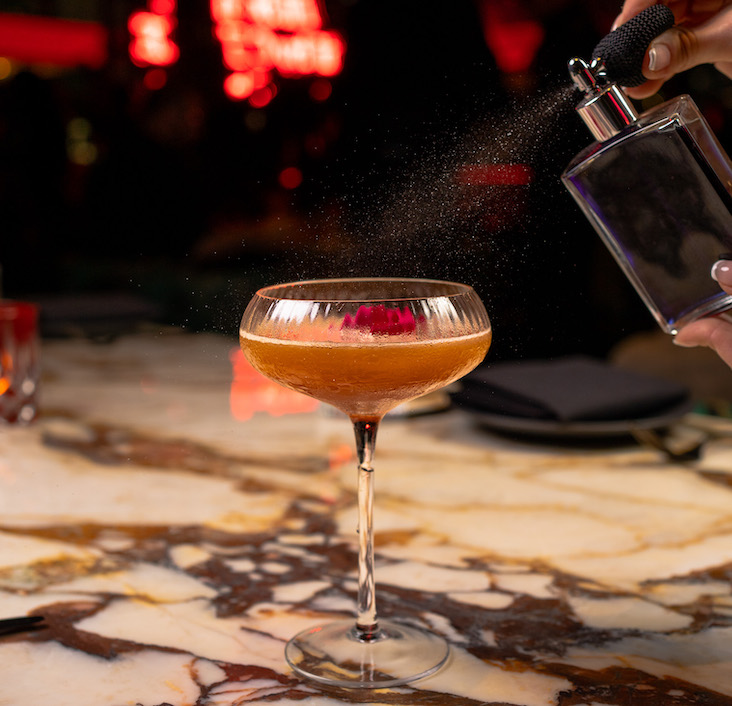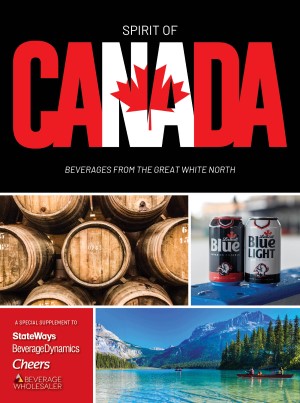keep your draft sales flowing.
photography by Kent Hanson
In San Francisco, ThirstyBear owner and brewer Ron Silberstein increases beer sales with the Five E’s: experimentation, exhibition, education, events and eats.
THERE’S A LOT TO BE SAID for anticipation as a marketing tool. Take draft beer, for instance: thirsty customers scanning the beer list and tap handles, deciding what to order, watching the bartender pull a cold mug from the freezer and admiring the slow pour of an expert. These days, though, it’s rare for a bartender to hear “Pour me a cold one.” They’re more likely to be asked, “What’s the original gravity of that brew?”
With the abundance of microbrews, seasonal beers, and specialty imports, you can expect today’s sophisticated beer drinker to demand more when he walks into your establishment. The customer’s interest in draft beers offers a major area of profit, if properly recognized and exploited.
Today’s operators need to be savvy marketers with the keys to creating a demand for draft beer. Call it the Five E’s: experimentation, exhibition, education, events and eats.
Into the Laboratory
If you list more than a few draft beers, some customers may be overwhelmed with the variety available. After scanning the many unfamiliar taps behind the bar, they may opt to settle for a familiar, safe bet. Although many customers have personal favorites, most are willing to try new drafts if they can sample. They might be hesitant to buy a pint if they’re not sure how they’ll like it once they’ve tasted. Enter flights and samplers of beer, which give guests a chance to experiment with their own tastebuds.
At New York City’s bustling Wall Street Kitchen and Bar, beverage manager Bobby Wong says draft beer is the reason many of their customers keep returning. With 125 tap lines, reputed to be the largest number of any establishment in the city of New York, Wall Street Kitchen and Bar offers 50 different draft beers and twice that number of bottled beers. But despite the larger variety of bottled beers, Wong estimates that 65-70% of their beer sales are draft beer.
All draft beers at Wall Street are sold in both 16-ounce pints and 12-ounce glasses, but it’s the flights of 7-ounce samples of different types of beer that get the customers discovering new favorites. Customers can try many categories: hand-pumped, special selections, pales, red/browns, weiss and whites, Belgium ales, British ales, lagers, pilsners, ambers, seasonals and ciders. It’s a fun way for customers to encounter new flavors without making too much of a commitment to a beer that is unfamiliar.
But don’t rely on experimentation alone to further your draft beer sales. “It’s a good idea to carry a few mainstream beers that people are familiar with,” advises Wong. “Many people want to experiment with new tastes, but their buddy may be a tried and true Bass drinker, and you want to make sure that you can offer that option.”
If You’ve Got It…
A customer can’t be tempted by beers he doesn’t see. It’s a simple rule, but one that’s often ignored. Making certain that all tapheads are visible behind the bar is arguably the least time consuming draft beer promotion available. With the proliferation of seasonal microbrews and limited availability brews such as Octoberfest beers, these tap handles are an obvious choice for passive marketing.
At the ThirstyBear Brewing Company, San Francisco, little things such as these are made to count.
Tabletents do yeoman promo duty here; one side highlighting the current special beer selection, sold in 3-, 12- and 22-ounce pours, and the availability of Belgian beers, and the flip side touting keg sales for home entertaining, half-gallon jug “growlers,” and Tuesday night’s “Cask Conditioned Ale” promo. A brew master visits the restaurant during the latter, offering samples of the ale and mingling with the customers. And ThirstyBear bartenders serve tasters on a laminated place mat with selected spots for each brew so the customer can keep track of their favorites. (All glassware is adorned with the ThirstyBear logo and coasters list the operation’s address, phone number and web site.)
Owner/head brewer Ron Silberstein advises using in-house and off-premise promotions to get your operation’s name out. “Often ThirstyBear will donate a keg to fund-raisers or other charitable events, and I’ll be on hand to pour the beer,” he says. “This accomplishes three things: you get your name out there, people get to sample the beer, and you contribute to the community. Everyone benefits.”
Back To School
Education is a two-tiered program, according to Silberstein. “Promotion starts in house,” he explains. “The education of the server is vital to the education of the customer. And only with an educated customer will you have demand for your product.” Before new staffers hit the floor, Silberstein gives them the ThirstyBear Brewing Company Beer Training & Information Manual, which includes a mission statement and in-depth descriptions of all the house beers, various brewing processes, common beer styles, a glossary of beer terms and a list of questions every server should know.
“Just as our staff needs to be knowledgeable about the food and service of ThirstyBear, they need to be just as knowledgeable about the beer we serve,” notes Silberstein. “That education is passed on to the customer. Often customers will come in and have a preference for commercial beer, but are interested in trying something new. If they tell the server what their usual choice is, our server is able to recognize the characteristics they prefer in beer and recommend a house brew based on those preferences.”
Mike Hale of Hale’s Ales Brewery and Pub, Seattle, agrees with Silberstein’s approach. Two to three times a month, Hale’s head brewer Jay Kipling hosts a class known as “Art of Beer 101,” held specifically for the hospitality industry. Kipling instructs the class about the complete brewing process, advancing their understanding of the various characteristics that result from each method and how they change from beer to beer. The net result? A server who can articulate his understanding of draft beer and thereby educate his customer.
Memorable Events
On-premise events can provide long-lasting memories to patrons who, given a successful promotion, will associate your establishment with a great time.
The Back Bay Brewing Company has the best view of the Boston Marathon: the finish line. To mark the event and tie the operation to it, a popular seasonal brew, “Last Runner’s Ale,” created by master brewer Tommy Mott, is renamed after the final runner to cross the finish line, honoring the unique sort of dedication it takes to complete the race.
Following the Marathon’s conclusion, Back Bay welcomes runners from all over the world to celebrate with plenty of the seasonal ale to go around.
At Gasthaus Bavarian Hunter in Stillwater, MN, owners Kim and Carl Schoene have created unparalleled demand with their niche-marketing draft beer selection. They serve only German beers on tap, and in the spring offer a limited supply of Spaten’s Maibock. “We start receiving calls in January about our Maibock and Octoberfest beers,” says Kim. “Because we have a limited supply of those particular beers, people want to know the date we receive the kegs so that they don’t miss it.”
Commemorating draft beer with a specific event can make it uniquely your own. Creating excitement around not only the event but the draft beer itself ensures that your establishment is known as THE place in town for the festivities. Annual traditions can take many forms, and finding the perfect fit may entail simply looking out your window.
Good Food Sells Better
Beer and food are a natural pair, but how the two are sold together can turn the traditional burger and beer into an Epicurean delight.
With the variety of beers available today, servers have another beverage besides wine to offer patrons as a complement to their food. At the ThirstyBear, Silberstein arms his staff with a chart outlining the types of beer that go with various types of food. For instance, grilled chicken breast would warrant a recommendation of a golden ale or wheat beer, while a grilled garlic chicken would pair nicely with a darker, more robust brew, such as stout or brown ale that could hold its own when paired with rich or robust foods. A golden ale or wheat beer is often recommended with seafood, in order to complement, but not overpower the taste of the dish.
At Canterbury Ales in Huntington, NY, owner Billy Hoest is a firm believer in the marriage of beer and food. About five times a year he hosts themed beer tastings on Sunday afternoons for Winterfest, Octoberfest, Rites of Spring, St. Patrick’s Day and the Super Bowl, to name a few. At the tastings, the beer doesn’t just complement the food; sometimes it can be found in the food.
Billy and his kitchen team start the planning with a list of 15-18 beers that’s then narrowed down to 10. Then the recipe hunt begins. Five courses are served, with two beers for each course. Working around a theme, such as Octoberfest, they revamp traditional recipes to either incorporate a specific beer into the recipe or simply complement a chosen beer.
The menus vary according to the flavor and spiciness in the beer. The Octoberfest menu, for instance, has included mesclun greens tossed in a grain mustard dressing enhanced with Stoudt’s Fest Beer, topped with grilled wursts and traditional German-style pot roast simmered in Paulaner’s Oktoberfest.
The surge of interest in quality draft beers is already there. Integrating that interest into the way you do business can take advantage of an unparalleled opportunity to make fresh, draft beer your specialty, not just in terms of volume and profit, but as your business.
Peg Wallace sips her favorite brews in San Francisco.
SPECIAL EVENTS
Although the arrival of Spaten’s Maibock creates excitement on its own at the Gasthaus Bavarian Hunter in Stillwater, MN, Kim and Carl Schoenes create excitement around other draft brews as well.
Every fall, they welcome the arrival of Spaten’s Octoberfest beer with their own festival, erecting a giant tent outside that can keep up to 800 people dry. “The festival starts at 5 p.m.,” reports Kim. “Last year we sold out at 4:30. People come from all over for our festivals.” Held during the last two weekends in September for the last 15 years, the Octoberfest celebration offers dancing, beer, food and a gift shop. And it has given birth to a spring counterpart, when, during the last weekend in June, the Schoenes host a Summerfest to celebrate the arrival of summer ales. They mail flyers all year long to the Gasthaus Bavarian’s mailing list promoting the festivals and the arrival of Maibock. But for the most part, the excitement the Schoene’s create around the draft beers has taken on a life of its own, and word of mouth has made sure the celebrations will continue. –PW




